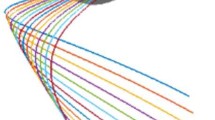Abstract
This paper deals with the optimal transfer of a spacecraft from a low Earth orbit (LEO) to a low Mars orbit (LMO). The transfer problem is formulated via a restricted four-body model in that the spacecraft is considered subject to the gravitational fields of Earth, Mars, and Sun along the entire trajectory. This is done to achieve increased accuracy with respect to the method of patched conics.
The optimal transfer problem is solved via the sequential gradient-restoration algorithm employed in conjunction with a variable-stepsize integration technique to overcome numerical difficulties due to large changes in the gravitational field near Earth and near Mars. The optimization criterion is the total characteristic velocity, namely, the sum of the velocity impulses at LEO and LMO. The major parameters are four: velocity impulse at launch, spacecraft vs. Earth phase angle at launch, planetary Mars/Earth phase angle difference at launch, and transfer time. These parameters must be determined so that ΔV is minimized subject to tangential departure from circular velocity at LEO and tangential arrival to circular velocity at LMO.
For given LEO and LMO radii, a departure window can be generated by changing the planetary Mars/Earth phase angle difference at launch, hence changing the departure date, and then reoptimizing the transfer. This results in a one-parameter family of suboptimal transfers, characterized by large variations of the spacecraft vs. Earth phase angle at launch, but relatively small variations in transfer time and total characteristic velocity.
For given LEO radius, an arrival window can be generated by changing the LMO radius and then recomputing the optimal transfer. This leads to a one-parameter family of optimal transfers, characterized by small variations of launch conditions, transfer time, and total characteristic velocity, a result which has important guidance implications. Among the members of the above one-parameter family, there is an optimum–optimorum trajectory with the smallest characteristic velocity. This occurs when the radius of the Mars orbit is such that the associated period is slightly less than one-half Mars day.
Similar content being viewed by others
References
Anonymous, The Viking Mission to Mars, Martin Marietta Corporation, Denver, Colorado, 1975.
LECOMPTE, M., New Approaches to Space Exploration, The Case for Mars, Edited by P. J. Boston, Univelt, San Diego, California, pp. 35–37, 1984.
NIEHOFF, J. C., Pathways to Mars: New Trajectory Opportunities, NASA Mars Conference, Edited by D. B. Reiber, Univelt, San Diego, California, pp. 381–401, 1988.
WERCINSKI, P. F., Mars Sample Return: A Direct and Minimum-Risk Design, Journal of Spacecraft and Rockets, Vol. 33,No. 3, pp. 381–385, 1996.
LINDORFER, W., and MOYER, H. G., Application of a Low Thrust Trajectory Optimization Scheme to Planar Earth-Mars Transfer, ARS Journal, Vol. 32, pp. 260–262, 1962.
STRIEP, S. A., BRAUN, R. D., POWELL, R. W., and FOWLER, W. T., Influence of Interplanetary Trajectory Selection on Mars Atmospheric Entry Velocity, Journal of Spacecraft and Rockets, Vol. 30,No. 4, pp. 26–430, 1993.
TAUBER, M., HENLINE, W., CHARGIN, M., PAPADOPOULOS, P., CHEN, Y., YANG, L., and HAMM, K., Mars Environmental Survey Probe, Aerobrake Preliminary Design Study, Journal of Spacecraft and Rockets, Vol. 30,No. 4, pp. 431–437, 1993.
BRAUN, R. D., POWELL, R. W., ENGELUND, W. C., GNOFFO, P. A., WEILMUENSTER, K. J., and MITCHELTREE, R. A., Mars Pathfinder Six-Degree-of-Freedom Entry Analysis, Journal of Spacecraft and Rockets, Vol. 32,No. 6, pp. 993–1000, 1995.
PASTRONE, D., CASALINO, L., and COLASURDO, G., Indirect Optimization Method for Round-Trip Mars Trajectories, Astrodynamics 1995, Edited by K. T. Alfriend, I. M. Ross, A. K. Misra, and C. F. Peters, Univelt, San Diego, California, pp. 85–99, 1995.
SPENCER, D. A., and BRAUN, R. D., Mars Pathfinder Atmospheric Entry: Trajectory Design and Dispersion Analysis, Journal of Spacecraft and Rockets, Vol. 33,No. 5, pp. 670–676, 1996.
LEE, W., and SIDNEY, W., Mission Plan for Mars Global Surveyor, Spaceflight Mechanics 1996, Edited by G. E. Powell, R. H. Bishop, J. B. Lundberg, and R. H. Smith, Univelt, San Diego, California, pp. 839–858, 1996.
WAGNER, L. A., JR., and MUNK, M. M., MISR Interplanetary Trajectory Design, Spaceflight Mechanics 1996, Edited by G. E. Powell, R. H. Bishop, J. B. Lundberg, and R. H. Smith, Univelt, San Diego, California, pp. 859–876, 1996.
LOHAR, F. A., MISRA, A. K., and MATEESCU, D., Mars-Jupiter Aerogravity Assist Trajectories for High-Energy Missions, Journal of Spacecraft and Rockets, Vol. 34,No. 1, pp. 16–21, 1997.
MIELE, A., Flight Mechanics, Vol. 1: Theory of Flight Paths, Addison-Wesley Publishing Company, Reading, Massachusetts, 1962.
MIELE, A., HUANG, H. Y., and HEIDEMAN, J. C., Sequential Gradient-Restoration Algorithm for the Minimization of Constrained Functions: Ordinary and Conjugate Gradient Versions, Journal of Optimization Theory and Applications, Vol. 4,No. 4, pp. 213–243, 1969.
MIELE, A., TIETZE, J. L., and LEVY, A. V., Comparison of Several Gradient Algorithms for Mathematical Programming Problems, Omaggio a Carlo Ferrari, Edited by G. Jarre, Libreria Editrice Universitaria Levrotto e Bella, Torino, Italy, pp. 521–536, 1974.
MIELE, A., PRITCHARD, R. E., and DAMOULAKIS, J. N., Sequential Gradient-Restoration Algorithm for Optimal Control Problems, Journal of Optimization Theory and Applications, Vol. 5,No. 4, pp. 235–282, 1970.
MIELE, A., TIETZE, J. L., and LEVY, A. V., Summary and Comparison of Gradient-Restoration Algorithms for Optimal Control Problems, Journal of Optimization Theory and Applications, Vol. 10,No. 6, pp. 381–403, 1972.
MIELE, A., and DAMOULAKIS, J. N., Modifications and Extensions of the Sequential Gradient-Restoration Algorithm for Optimal Control Theory, Journal of the Franklin Institute, Vol. 294,No. 1, pp. 23–42, 1972.
HEIDEMAN, J. C., and LEVY, A. V., Sequential Conjugate Gradient-Restoration Algorithm for Optimal Control Problems, Parts 1 and 2, Journal of Optimization Theory and Applications, Vol. 15,No. 2, pp. 203–222 and 223–244, 1975.
MIELE, A., and WANG, T., Primal-Dual Properties of Sequential Gradient-Restoration Algorithms for Optimal Control Problems, Part 1: Basic Problem, Integral Methods in Science and Engineering, Edited by F. R. Payne et al., Hemisphere Publishing Corporation, Washington, DC, pp. 577–607, 1986.
MIELE, A., and WANG, T., Primal-Dual Properties of Sequential Gradient-Restoration Algorithms for Optimal Control Problems, Part 2: General Problem, Journal of Mathematical Analysis and Applications, Vol. 119,Nos. 1–2, pp. 21–54, 1986.
MIELE, A., Recent Advances in the Optimization and Guidance of Aeroassisted Orbital Transfers, The 1st John V. Breakwell Memorial Lecture, Acta Astronautica, Vol. 38,No. 10, pp. 747–768, 1996.
MIELE, A., and WANG, T., Near-Optimal Highly Robust Guidance for Aeroassisted Orbital Transfer, Journal of Guidance, Control, and Dynamics, Vol. 19,No. 3, pp. 549–556, 1996.
MIELE, A., and WANG, T., Robust Predictor-Corrector Guidance for Aeroassisted Orbital Transfer, Journal of Guidance, Control, and Dynamics, Vol. 19,No. 5, pp. 1134–1141, 1996.
RISHIKOF, B. H., MCCORMICK, B. R., PRITCHARD, R. E., and SPONAUGLE, S. J., SEGRAM: A Practical and Versatile Tool for Spacecraft Trajectory Optimization, Acta Astronautica, Vol. 26,Nos. 8–10, pp. 599–609, 1992.
Author information
Authors and Affiliations
Rights and permissions
About this article
Cite this article
Miele, A., Wang, T. Optimal Trajectories for Earth-to-Mars Flight. Journal of Optimization Theory and Applications 95, 467–499 (1997). https://doi.org/10.1023/A:1022661519758
Issue Date:
DOI: https://doi.org/10.1023/A:1022661519758




